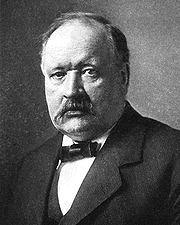|
|
The science of global warming has been around for more than a century.
As early as 1896, Svante Arrhenius, a Swedish scientist and engineer, published a paper entitled
"On the influence of carbonic acid
in the air upon the temperature of the ground," where he clearly expounded on the science
of global warming.
Arrhenius' lifetime work, which spanned nearly five decades,
went beyond the fields of physics and chemistry
to encompass the [new] disciplines of physical chemistry, geophysics, astrophysics,
geochemistry, and biochemistry.
In 1903, Arrhenius won the Nobel Prize of Chemistry for his electrolytic theory of dissociation of ionic substances upon their dissolution in water, the subject of his 1884 thesis.
Later, Arrhenius devoted his energies to the advancement of technology and popular science.
Between 1906 and 1925, he wrote eleven books popularizing science and summarizing scientific progress.
By all accounts, the scientific credentials and accomplishments of Svante Arrhenius are exceptional.
Toward the middle of his career, Arrhenius became fascinated by the role of carbon dioxide in climate control. His seminal work on the subject was the article published in 1896 (op. cit.).
One may ask how good was this article, given that it was published more than a century ago.
First, we must recognize that carbon dioxide was referred to as carbonic acid when Arrhenius was writing, so it is clear from the article's title that he was referring to the problem that we are now facing.
In 2004, Vice-President Al Gore thrust global warming into the arena of world public opinion.
Prior to that time, and even to this date, skeptics have labeled the science of global warming as bad.
However, the label is less than twenty years old, which means that only recently has this science been referred to as "bad."
For more than eighty years, global warming was largely ignored by most people, ostensibly because they were not affected directly by its consequences.
Now that global warming is here and that it threatens to affect people's lives, all of a sudden it is also ugly.
There are those who argue that fixing global warming will cause irreparable harm to the world economy, presumably in the belief that the health of the world economy should take precedence over the survival of the biosphere as we now it.
But let's examine the work of the man who must have been among the first to spend many hours of study and reflexion on the science of global warming: Svante Arrhenius.
His article is masterful; unfortunately, its scientific language limits its appeal to a broad audience.
In this article, we endeavor to revisit Arrhenius' work, in the hope of throwing additional light on the subject.
The interested reader is left to ponder whether the science is good, bad, or ugly and, accordingly, to take a stand that befits him/her as a concerned and informed occupant of the Earth.
Arrhenius' first question was:
"Is the mean temperature of the ground in any way influenced by the presence of heat-absorbing gases in the atmosphere?"
He reasoned that the air retains heat in two ways: (1) by selective diffusion as the heat passes through the air; and (2) by absorption, since some atmospheric constituents absorb great quantities of heat.
Nitrogen (N2) and oxygen (O2), the atmosphere's primary constituents, are homonuclear diatomic molecules, too tightly bound together to be able to absorb heat through vibration.
The selective absorption of heat is accomplished by carbon dioxide (CO2) and water vapor (H2O), which are present in the air in small quantities.
These two molecules consist of two elements and more than two atoms, bound together loosely enough to be able to vibrate somewhat with the absorption of infrared radiation [heat] (Fig 1).
Eventually, the vibrating molecule will emit the radiation again and it will likely be absorbed by yet another molecule.
This absorption-emission-absorption cycle serves to keep part of the heat near the Earth's surface, insulating the latter from the cold of outer space.
Other heat-absorbing compounds such as methane (CH4) and nitrous oxide (N2O) are also present in the atmosphere, albeit at smaller concentrations.
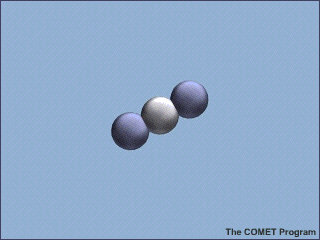 Fig. 1 Heat absorption of carbon dioxide molecule through vibration (Source: University Corporation for Atmospheric Research). |
Arrhenius calculated the heat absorption coefficients of carbon dioxide and water vapor, enabling him to draw conclusions about the thermal balance of the near-ground air.
Then, he set out to calculate the fraction of heat which would be absorbed by the Earth's atmosphere containing selected amounts of carbon dioxide and water vapor.
He developed a table to express the transparency of the atmosphere [i.e., its ability to pass heat] as a function of specific quantities of carbon dioxide and water vapor (Table III, op. cit.).
Predictably, the greater the concentration of either of these gases, the lesser is the transparency of the atmosphere and, consequently, the greater is its capacity to absorb heat.
Arrhenius then asked himself a second question:
"How does the temperature of the ground depend on the absorptive power of the air?"
He reasoned that the Earth was in thermal equilibrium from natural sources over a one-year period.
Thus, he was able to concentrate on the changes in air temperature due to changes in the air's transparency [absorptivity].
Using finite mathematics [numerical analysis], he performed a thermal balance of the lower atmosphere, which enabled him to calculate mean annual temperature changes across the latitudes for postulated variations in carbon dioxide concentration.
He developed a table showing temperature increases/decreases across the latitudes for the following ratios of future-to-present carbon dioxide levels: 0.67, 1.5, 2.0, 2.5, and 3.0 (Table VII, op. cit.).
To quote from this table, a doubling of the amount of carbon dioxide would produce a temperature increase ranging from a minimum of 4.95oC near the Equator (latitudinal range 0-10o N, or 0-10o S), to a maximum of 6.05oC in the Arctic (latitudinal range 60o-70o N).
This latter accomplishment is remarkable since more than one-hundred years later the issue is still the subject of much debate.
Arrhenius concluded, based on detailed calculations and analysis, that a geometric increase in carbon dioxide would cause an arithmetic increase in air temperature.
It is interesting to note that what may have inspired Arrhenius' extraordinary scientific discovery, to say nothing of his meticulous diligence, was not so much global warming, but rather global cooling [recall that he was living in Sweden].
Since the phenomenon can go either way, he concerned himself with the probable cause of the last Ice Age (Fig. 2).
He reasoned that his findings could justify temperature variations of 5oC-10oC and that the change could go either way, depending on the circumstances.
 Fig. 2 Ice cover during the last Ice Age. Fig. 2 Ice cover during the last Ice Age.
|
Geological evidence points to the certainty that during Tertiary times, the temperature of the Arctic must have exceeded the present (1896) temperature, probably by 8oC-9oC.
Conversely, measurements of snow-line displacement suggest that during the Ice Age the temperature must have been 4oC-5oC lower than present.
This prompted Arrhenius to ask a third question:
"How much should the carbon dioxide vary in order for the temperature to attain the same values as the Tertiary and Ice Age periods, respectively?"
His calculations showed that the temperature in the Arctic would rise about 8oC-9oC if the carbon dioxide increased to 2.5 to 3.0 times the present (1896) level.
Likewise, he showed that in order to get the temperature of the Ice Age between the 40o and 50o parallels, the carbon dioxide in the air would have to drop to 0.62 to 0.55 of its present level.
Finally, Arrhenius asked a crucial question:
"Is it probable that such great variations in carbon dioxide could have occurred within relatively short geologic times?"
On this issue, Arrhenius deferred to his colleague, Prof. Högbom, quoting extensively from him.
When the carbon dioxide in the air [assuming 300 ppmv, c. 1896] is spread evenly across the Earth, it produces a layer of carbon of 1 mm thickness.
How does this quantity compare with the quantities that are being transformed by Nature and humans?
According to Arrhenius, the world's industrial use of coal (500,000,000 tons per year, c. 1896) amounts to a layer of 0.003 mm (Fig 3).
[For comparison, in 2007, the world consumption of coal was 6,300,000,000 tons, and that of petroleum was 4,891,000,000 tons].
On the whole, the total quantity of carbon dioxide fixed in sedimentary formations is about 25,000 greater that the quantity present in the air (op. cit.).
Every molecule of carbon buried under the Earth's surface must have existed and passed through the atmosphere over the course of geologic time.
Thus, the probability of substantial variations in the amount of carbon dioxide in the air is very real indeed, while not all variations may have always proceeded in the same direction.
 Fig. 3 Anthracite (carbon mineral). Fig. 3 Anthracite (carbon mineral).
|
A mass balance of carbon led Arrhenius to conclude that the main source of juvenile [i.e., new] carbon in the air is volcanic eruptions.
Vulcanologists recognize that this source has not always flowed regularly and uniformly through the eons.
Therefore, natural atmospheric carbon dioxide variations (increases or decreases) must be adscribed to natural variations in the quantity of carbon dioxide spewed out by volcanic activity.
We note that while Arrhenius did not explicitly suggest that the burning of fossil fuels would cause global warming, it is clear from his paper that he was aware that fossil fuels are a potentially significant source of carbon dioxide.
Arrhenius could not have predicted the enormeous increase in fossil fuel consumption that followed the invention and widespread use of automobiles, trains, ships, airplanes, and other means of self-propelled transportation.
Also, he could not have predicted the substantial improvements in sanitation and public health that led to the population explosion of the 20th century.
Yet, within his limited perspective, he still concluded that large variations in atmospheric carbon dioxide were indeed probable.
Still, he could not have predicted that humans would soon thereafter engage in an experiment [with our Earth, the quintessential prototype] of wide-ranging proportions and global impact: the indiscriminate burning of fossil fuels to support the sustained economic activity that characterized the 20th century.
Arrhenius' predictions were received with great interest by the world's scientific community, but waned in time
until Carl Rossby initiated
atmospheric measurements of carbon dioxide in the 1950s.
The question of Arrhenius' greenhouse effect was taken up as a major topic for the 1957-1958 International Geophysical Year.
As a follow-up, permanent carbon dioxide measurements were undertaken under the leadership of Charles Keeling, of the Scripps Institution of Oceanography, California.
Thanks to Keeling's skill and perseverance, there is now a five-decade record of carbon dioxide measurements, clearly pointing to a steady growth pattern (Fig. 4).
The carbon dioxide concentration is presently (2017) at 404 ppmv and rising about 2 ppmv annually.
This places well beyond doubt the fact that humans have now replaced volcanos as the primary agents of global geophysical change.

|
Fig. 4 The Keeling graph.
Is there any direct evidence that the world is getting any warmer?
NASA's Goddard Institute of Space Studies, in New York, has developed a chart showing measurements of global mean land-ocean temperature anomaly, from 1880 to the present (Fig. 5).
This chart clearly shows an increase of about 0.6oC over the past fifty years.
Thus, a 22% increase in atmospheric carbon dioxide has apparently led to a 0.6oC increase, according to NASA.
Following this trend, a doubling of carbon dioxide would lead to a 2.72oC increase in the temperature anomaly.
Arrhenius's calculations would not be too far off.
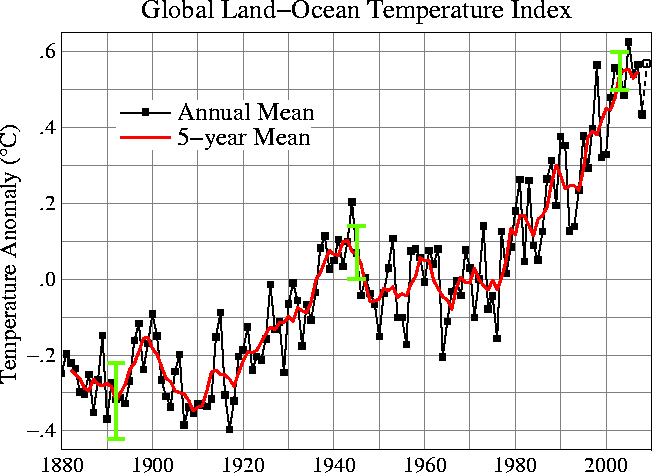
|
Fig. 5 Global annual mean land-ocean temperature anomaly, 1880-present (oC) (Source: NASA).
To close, Arrhenius was essentially correct in identifying and calculating the climate-regulating capacity of the atmospheric greenhouse gases, in particular, carbon dioxide.
The system was intended by Nature to be cybernetic, i.e., self-controlling, with periods of warming followed by periods of cooling.
However, over the past half century, humans have endeavored to throw a monkey wrench into the natural system, destabilizing it.
The resulting positive feedback now threatens to disable the cybernetic functioning of the ecosphere.
A final thought: Atmospheric carbon dioxide acts like a blanket, keeping some of the heat below it from escaping to space.
The greater the amount of carbon dioxide, the thicker the blanket and, consequently, the greater the amount of heat retained.
While the blanket's actual thickness is subject to seasonal variations (see insert in Fig. 4), the decidedly upward trend of the past fifty years should be a cause for preocupation.
The blanket is getting thicker with time, regardless of the seasons; it has gotten 22% thicker over the past fifty years.
This may be the reason that many glaciers around the world are receding; see, for example, Figs. 6 and 7.
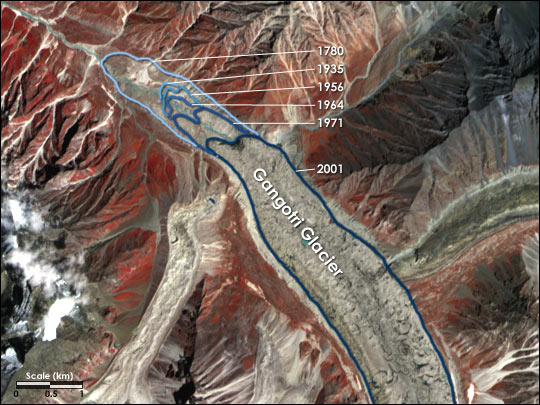
|
Fig. 6 Gangotri glacier, the Himalayas, in recession (Source: NASA).
 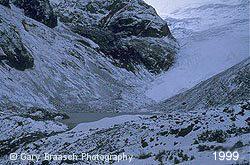
|
Fig. 7 Ururashraju glacier, White Range, Peru, has retreated about 500 m between 1986 and 1999
(Credits: Gary Braasch photography).
1 Arrhenius, S., 1896. On the influence of carbonic acid in the air upon the temperature of the ground. Philosophical Magazine and Journal of Science, Series 5, Vol. 41, No. 251, April, 237-276.
2 Arrhenius, G., K. Caldwell, and S. Wold. 2008. A tribute to the memory of Svante Arrhenius (1859-1927), a scientist ahead of his time. Presented at the 2008 Annual Meeting of the Royal Swedish Academy of Engineering Sciences, Stockholm, Sweden.
